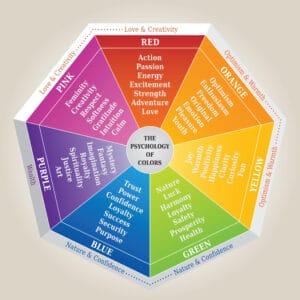Branding is more than an iconic logo, though, and multi-billion-dollar companies aren’t the only ones who need to prioritize it. It’s just as important for smaller companies to prioritize their branding.
In this article, we cover what this marketing term means, why it’s important, how to establish a strong brand for your company, and more.
A Brief History Of Branding
Branding goes as far back as the 1500s and has gone through many transformations since its inception. It was first introduced when villagers needed to indicate ownership of their livestock. Cattle were marked with burned wood in distinctive symbols that represented their owner. Fast forward to the industrial revolution in the 18th and 19th centuries when we see the birth of the trademark, which consists of words, phrases, designs and colors that were legally registered to represent a company.
In the mid-2oth century, brands began taking extra measures to look and feel different from their competitors by including an emotional angle to their marketing strategies.
Nowadays, basic branding is a must for every company, but standing out in the crowded digital landscape is more difficult than ever before. Before we tackle the “how” of branding, we need to agree on a definition.
What Is Branding?
Since its beginning, branding has been about standing out or expressing ownership. It’s grown to represent more than just a product, but the overall essence of a company. With storytelling at its foundation, it represents a promise to your customers that what they receive from you is and always will be a reflection of your responsibility to them. This is what makes your company memorable and desirable.
Your brand reflects all aspects of your organization in its customer service to marketing materials. For example, what do we know about Nike’s branding? We know they dominate their industry, and their logo is easily identified. If you dig a little further, you’ll find that Nike’s mission is to “bring inspiration and innovation to every athlete* in the world.” The asterisk says, “If you have a body, you are an athlete.”
Nike is trusted by consumers, and although their products are great quality and have been around for years, their success is not because they are the best or the first. They have branded themselves as an organization that resonates with consumers on an emotional level. They’ve built a community that millions of people love to be a part of.
It’s undeniably important to establish your brand no matter what size your company is. In the beginning stages, a cohesive look and feel signals that your company is attention worthy. Building a customer base is crucial and must happen before you develop a strong reputation.
How To Get Your Business’s Branding Right
So, how do you get started? First, it will be useful to label your brand type. Read about the different types of brands here. Entrepreneur also offers some tips for defining your brand that start with answering these questions:
- What is your company’s mission?
- What are the benefits and features of your products or services?
- What do your customers and prospects already think of your company?
- What qualities do you want them to associate with your company?
When you’ve answered the most important questions pertaining to your brand, you can research what visual elements best represent it. For instance, choosing the color or colors associated with your brand is highly important. Colors have psychological effects on consumers. Take red for example, which is often associated with love, power, energy, anger and danger. In marketing, it’s often linked to clearance sales or fast-food restaurants. McDonalds, Burger King, Chik-fil-A, Arby’s and Jack in the Box are a few of the many fast food restaurants with bright red branding.
Consider what feelings you want to elicit from consumers and what will represent your company best. Color isn’t the only element that matters. Developing a logo that is true to your brand is essential. You’ll want something that’s simple, clever and memorable.
When you begin creating marketing materials such as social media templates, advertisements, website pages and email signatures, your logo should be present. Make sure your visual elements embody the message you want to send about your brand. You can’t control how your brand is perceived, but you can exude professionalism and cohesiveness with consistent and intentional branding.
Optics aside, voice. Whether you have a storefront or operate entirely online, how you present yourself to customers, clients and the media must also represent your brand in a positive way. Do you want your brand to be friendly? Are you trying to present your company as a formal and professional one? Depending on which goal you’re trying to achieve, you can develop a voice – a way of communicating – for your brand.
Articles, for example, can be written from a personal perspective if you have a friendly brand. These articles can take the point of view of those behind the brand. The way you answer phone calls or the signature at the end of your emails should represent the same voice. The same goes for the tweets you send or Facebook posts you publish.
Why Is Branding Important?
All the elements of your branding – your mission, your color scheme, your voice and other qualities – should be integrated into your marketing strategy. The following are just a few more reasons why branding matters:
- It supports your marketing efforts! When your branding is integrated into every part of your business, people become familiar with your brand, and familiarity is a huge driving factor for market decisions. Even if someone isn’t immediately ready to make a purchase, cohesive branding will stay in their mind longer than if your branding is unpredictable and disorderly.
- It distinguishes your products or services from similar companies. The promise that your branding makes to consumers enables them to better connect with or relate to in some way. If your brand is notable, it is likely to be chosen over its competitors.
- It will simplify media relations. You’ll be able to have a visual style guide ready for online publications if needed. The idea here is to avoid having to explain the details about your brand and how it should be presented.
- It is great for your employees. Investing in aspects of branding that keep your team motivated, such as branded merchandise or apparel, can promote a sense of unity and yield positive results in the workplace.
- Branding builds trust. A strong brand paired with a dependable product or service creates trust between your brand and consumers known as brand loyalty. According to Investopedia: “Brand-loyal customers believe that a certain brand represents both higher quality and better service than any competitor—and the price does not matter.” If consumers trust your brand and have a strong positive association with it, they’ll likely return to you for the same product and even try others from you.
You’ve Established Your Brand. What Next?
It’s important to reiterate the value of consistency here. Without continued effort, your branding will fall flat. In addition to being consistent, flexibility can also help. Keep an eye on what performs well. Doing so will help you stay fresh and relevant in a dynamic market.
As you build a customer base and execute marketing campaigns, focus on build your community. You can target consumers who share your organization’s values. Similarly, you can find employees who do the same. Growing a community with your brand will promote brand loyalty among your desired audience – a strong indicator of long-term success.
How To Rebrand
Branding can be complicated without the right experience. In some cases, it’s possible you will need to revisit your branding for a refreshed look or a competitive advantage. After all, innovation yields profitability. Here are some tips from Three Girls’ CEO, Erika Taylor Montgomery, for how to rebrand:
- Get Feedback: Talk to as many people as possible. Speak with customers, employees, partners and anyone willing to take a second to give you honest feedback. Everyone has an opinion, so sort through your feedback and determining which ideas are the most important to your rebranding efforts.
- Study The Enemy: You can never do too much research. Check out what other businesses are doing that is making them so successful. Also, think about what your business is not doing or doing wrong and how it can improve. There is nothing wrong with taking a page out of a competitor’s marketing playbook, but if you’re a small business, stay original and define yourself by what chains cannot afford to do.
- Determine Your Goal: Once you have gotten your feedback and have determined which areas need new focus, clearly define the goals you want to achieve with your brand. Are you correctly targeting your core audience? Does your name, logo, marketing content and website reflect that?
- Communicate, Communicate, Communicate: This is not a time to be coy. If you are going to make a change to your business, keep all communication channels open. Make sure your new brand is clearly and effectively communicated to all parties, internal and external. This includes current clients, potential clients and colleagues. Communication is verbal (how you present and talk about your business) as well as visual (logo, collateral and website) and should be carried through your entire online presence, including social media.
Do thorough research about your customers’ perceptions of your company, know the market you’re involved in and know your goals to accomplish a successful rebrand.
Don’t underestimate the power of branding! No matter how small your company is, your branding is the foundation of your business. Developing your identity as a company and staying true to it will position you well in a market that is more saturated than ever before.
Three Girls Media Can Help With Your Branding!
Our team of marketing professionals at Three Girls Media are experts in crafting brands. Contact us today for a complimentary 30-minute consultation with our CEO!
Special Offer:
Sign up for a complimentary consultation during January and receive an Email Marketing Guide valued at $475! We offer a 30-minute phone consultation with our CEO and can answer your questions and discuss your specific marketing needs – no strings attached. Call 360-955-1410 or contact us today to arrange your consultation!




